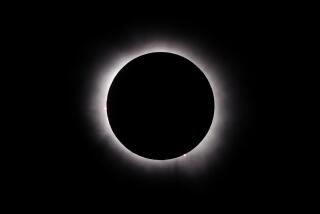What’s the cloud forecast for the solar eclipse in Los Angeles?

- Share via
Following a series of storms rolling through Southern California over the last few weeks, the skies are expected to be mostly clear Monday just in time to give Angelenos an unobstructed view of the solar eclipse.
There are only expected to be a few small clouds in the Los Angeles area near the eastern San Gabriel Mountains, but even hikers on those peaks will still be able to catch the eclipse, according to National Weather Service meteorologist Kristan Lund.
“It should be pretty clear,” she said. “People should have unblocked viewing of the solar eclipse.”
According to calculations by NASA, areas to the south and east of Los Angeles will see about 50% obscuration — the moon shrouding half of the sun — while much of the rest of the state will see around 25%. A total solar eclipse won’t be visible in this area again until 2044.
L.A. is expected to see 48.6% obscuration around 11:12 a.m.
Though there won’t be totality in California, the state will still enjoy an impressive partial eclipse in the late morning — if the skies remain cloud-free.
A weather pattern that has sent a series of storms over California, pushed Los Angeles to a new two-year rain total not seen since the late 1800s. There’s about a 20% chance that Los Angeles will see another storm with about less than a tenth an inch of rain Friday night into Saturday night, but that’s still subject to change as it gets closer to the weekend.
Skies are also expected to be mostly clear for Riverside and San Bernardino, according to Lund.
Temperatures should range Monday around the 70s, including the mid-70s for downtown Los Angeles.
The eclipse could actually bring temperatures down a few degrees from the weather forecast, according to Lund. Because the eclipse is occurring during L.A.’s solar noon — when the sun reaches the highest point in the sky — it will affect the radiation that comes into the area.
More to Read
Sign up for Essential California
The most important California stories and recommendations in your inbox every morning.
You may occasionally receive promotional content from the Los Angeles Times.















